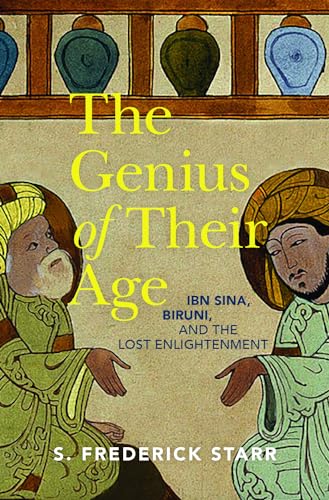The Genius of Their Age: Ibn Sina, Biruni, and the Lost Enlightenment
- By S. Frederick Starr
- Oxford University Press
- 312 pp.
- Reviewed by William Rice
- December 6, 2023
Meet Central Asia’s original polymaths.

Defenders of Islamic culture against broad-stroke criticism of its fundamentalist bent will often note that it boasted a robust intellectual life during Christendom’s Dark Ages. The Genius of Their Age: Ibn Sina, Biruni, and the Lost Enlightenment, by S. Frederick Starr, burnishes that reputation with a study of two particularly brilliant 11th-century Central Asian scholars. Between them, they advanced our knowledge in a startling range of fields stretching from medicine to astronomy. They were the prime movers of an awakening that the author argues “equaled, and in some respects surpassed” the European Renaissance of 500 years later.
Among Biruni’s contributions to science: the concept of specific gravity central to the field of chemistry; the full development of trigonometry (the sines, cosines, and tangents of triangles that facilitate distance measurements); a taxonomy of plants that Starr calls unmatched until Carl Linnaeus gave us all those Latin names for living things seven centuries later; and the disentanglement of astronomy from astrology.
Fewer such specific innovations are attributed to Ibn Sina (though he did coin the Arabic word for retina). His great breakthroughs were instead methodological. Starr credits him with the creation of what in the West would eventually be called “scholasticism”: the careful incorporation of Classical pagan learning into a monotheistic framework — in Ibn Sina’s case, Islam, and later in Europe, Christianity. His “Canon of Medicine” was the standard text in the West for centuries and, according to Starr, “did more than any other single work to forge the medical profession.”
Ibn Sina, the more famous of the two, even proved the existence of God using a reasoned analysis that was in Starr’s estimation “without precedent in antiquity, the Muslim world, or in the West.”
The pair are fitting subjects for a double biography. They were close contemporaries who ranged over the same geography. They were academic celebrities much sought out by rulers trying to ornament their courts with intellectual splendor. And they often had to switch such princely patronage hurriedly as they were chased around Asia by nearly constant warfare.
Not surprising for their era and class, politically, Biruni and Ibn Sina were believers in enlightened authoritarianism: They “shuddered at the prospect of men and women managing their own communities.” Starr goes to some length to build a sturdy case for the piety of both men against claims and evidence to the contrary. Wedded to their work, neither man married nor raised a family.
But their differences roughly equaled their similarities. Biruni’s life was austere and socially isolated, while Ibn Sina (despite his Muslim faith) pursued pleasures of the flesh amongst a large entourage of acolytes. Although they were both polymaths, Biruni delighted in the details, while Ibn Sina sought to illuminate the whole.
Starr’s tone is earnest and admiring. Like every biographer, he’s obviously grown close to his subjects. Like every good one, he’s tried to maintain his objectivity. This includes acknowledging that, however remarkable the two men were, especially for their time, it was a very different time:
“That Ibn Sina devoted an entire book to explaining how to control, clothe, and feed armies of slaves scarcely burnishes his modern reputation as a humanist.”
For anyone not engaging with Arabic nomenclature on a regular basis, keeping track of what (to a Western reader) seem like a lot of very similar names — of both people and places — is daunting. Maps and a glossary would be welcome aids. Yet some aspects of the story are sadly familiar to readers one millennium removed, including the murderous competition between the Sunni and Shia branches of Islam and the routine suppression of the Kurds.
Of course, typical Westerners only became aware of those phenomena because they factor into the ongoing conflict with radical Islam. The advent of long-distance sea travel transformed Central Asia — which had been the center of the world, where cultures and ideas from three continents met and contested — into the planet’s forgotten corner. Starr’s pair of scholars studied Aristotle, met with Chinese emissaries, and mapped the known world at a time when Europeans were still cowering in forest villages and plundering dimly understood Roman ruins.
Still, it’s striking how, in the men’s scholarship, sophisticated intelligence and comical ignorance comfortably coexist. (The same is undoubtedly true of modern works, though we don’t know it yet.) Despite all his contributions to astrology, Biruni never accepted the theory put forth by Indian scholars that the Earth rotates daily on its axis. In Ibn Sina’s monumental synthesis of knowledge, “The Cure,” he displays a nuanced appreciation of how geological change comes both incrementally and through cataclysm, then elsewhere confidently explains that thunder is caused by the collision of big rocks.
There’s no announcement of socially edifying goals at the beginning of Starr’s tale. But at the end, he notes that the territory over which Biruni and Ibn Sina roamed 1,000 years ago — since divided into nation states that include Iran and Afghanistan — now groans under anti-intellectual extremism. Still, he expresses the wistful hope that his two subjects’ “readiness…to take scientific, philosophical, or religious orthodoxies head-on” might inspire the region to a new flowering of brave, independent thought.
William Rice is a writer for political and policy-advocacy organizations.

